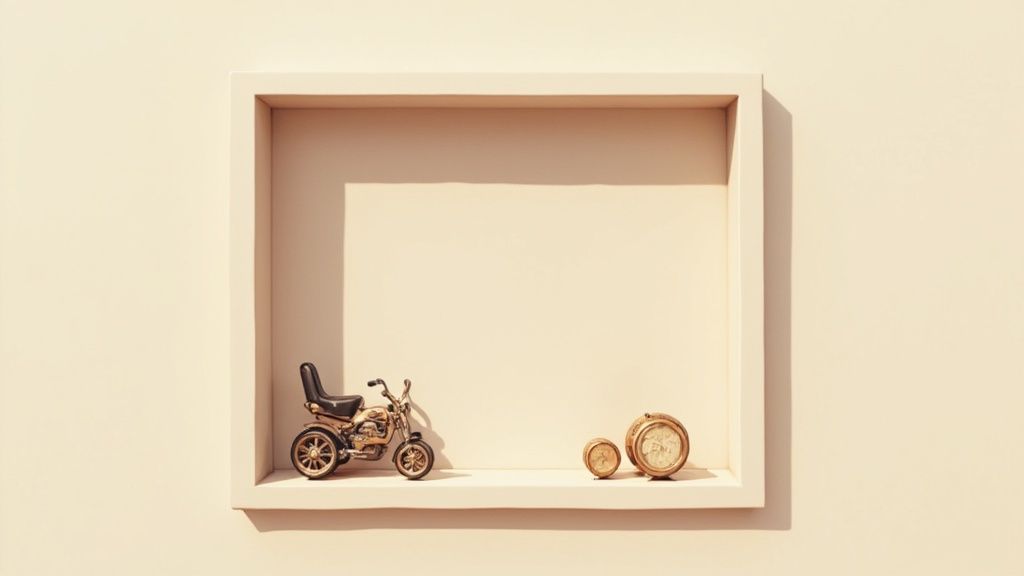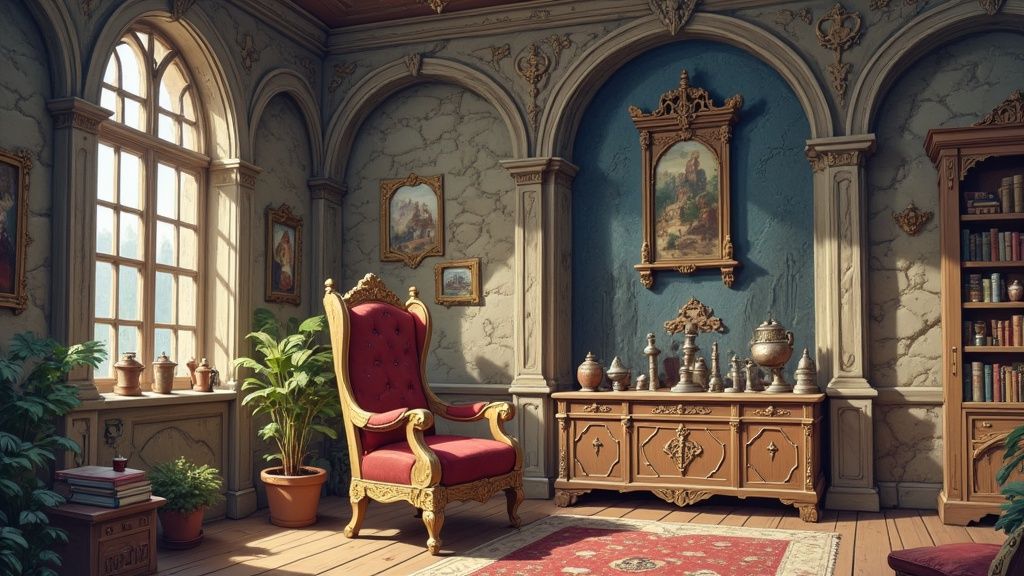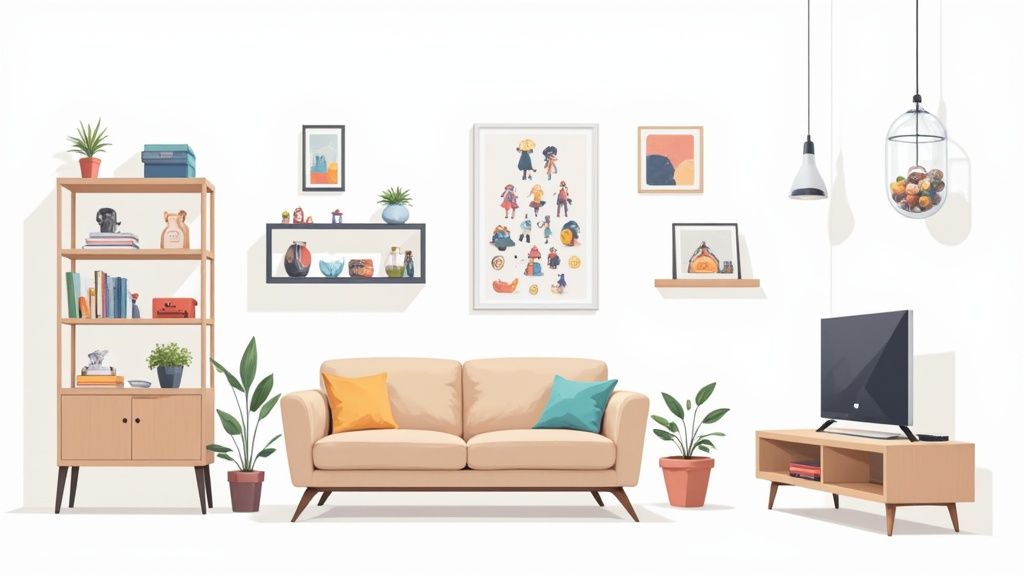Every collection tells a story, but how you display it brings that narrative to life. Moving your prized possessions from dusty boxes to a place of honor can transform your space and deepen your appreciation for each item. However, finding the right display solution can be challenging. You need ideas that not only look great but also protect your items and fit your personal style. This guide offers seven distinct and actionable collectible display ideas, moving beyond generic shelving to offer sophisticated, creative, and practical solutions for every type of collector.
Before you choose a method, understanding the story and value of your items is key. An app like Curio can be invaluable here. By simply taking a photo, you can instantly identify an item, learn its history, and get an estimated market value. This knowledge helps you decide which pieces deserve the most prominent placement and what kind of protection they might need. This process elevates a simple assortment of objects into a curated, meaningful exhibition. We will explore everything from immersive dioramas and elegant floating shelf galleries to interactive digital showcases, ensuring you find the perfect way to make your collection shine.
1. The Storyteller's Stage: Mastering the Shadow Box Display
A shadow box is far more than a simple frame; it's a miniature, three-dimensional stage for your collectibles. This enclosed display case, with its deep frame and protective glass front, allows you to transform static objects into a dynamic narrative. By layering items, backgrounds, and even lighting, you can build a contained, compelling world that tells a story. This method is one of the most effective collectible display ideas for items rich in context.
Unlike a flat display, a shadow box invites viewers to look closer, discovering the relationships between different pieces. It elevates the act of displaying items from simple organization to a true art form, giving each collection its own curated, museum-quality exhibit. The key is to think like a set designer, using depth, hierarchy, and composition to guide the eye and evoke emotion.

Why Use a Shadow Box?
The primary advantage of a shadow box is its ability to protect and contextualize a collection simultaneously. It shields delicate items like paper tickets, fabric patches, and photographs from dust, UV light, and physical damage while grouping them together to create a cohesive theme. This approach is ideal for collections that are more than just a sum of their parts.
Expert Insight: Shadow boxes turn memories into art. A collection of a grandparent's military medals, dog tags, and a folded flag becomes a powerful tribute. Similarly, a musician’s first guitar pick, concert ticket, and a signed setlist can capture the beginning of their journey.
Practical Implementation and Examples
Creating an effective shadow box display requires thoughtful planning, not just random placement. Consider these examples:
- Sports Memorabilia: Arrange a game-winning baseball, the ticket stub from that day, a player card, and a patch from the team jersey. Use a background in the team's colors.
- Travel Souvenirs: Combine a transit pass from Paris, a pressed flower from the Alps, a few foreign coins, and a small map of a favorite neighborhood to commemorate a special trip.
- Vintage Toys: Place a few classic action figures against a backdrop printed with scenery from their original cartoon or comic book.
Pro-Tips for a Perfect Display
- Plan Your Layout: Before mounting anything permanently, lay your items out on a piece of paper the same size as your shadow box. Trace their positions to create a template.
- Use Archival Materials: For valuable or sentimental items, always use acid-free backing paper and museum-quality mounting putty or pins. This prevents discoloration and degradation over time.
- Incorporate Lighting: A small, battery-powered LED strip light installed along the inside top edge can dramatically enhance your display, illuminating details and creating a professional finish.
- Give It Space: Avoid overcrowding. The negative space between items is just as important as the items themselves. It allows each piece to stand out and contributes to a balanced, visually appealing composition.
2. Floating Shelf Gallery Wall
A floating shelf gallery wall moves beyond a single, static shelf, transforming an entire wall into a versatile and modern display canvas. This system uses multiple slim shelves, often arranged at varying heights and lengths, to create a dynamic, curated look. It offers a sense of open, airy organization that is both aesthetically pleasing and highly practical, allowing you to easily rotate, update, and interact with your collection.
This method is one of the most flexible collectible display ideas because it treats your items like art in a gallery. The wall itself becomes part of the composition, and the shelves act as minimalist pedestals. Popularized by interior design influencers and minimalist decor trends, this approach allows for an evolving display that can change with your collection or mood, ensuring it never feels stale.

Why Use a Floating Shelf Gallery?
The core benefit of a floating shelf gallery is its flexibility and accessibility. Unlike enclosed cases, this setup allows for effortless rearrangement. You can easily add new pieces, create seasonal themes, or simply refresh the look without dismantling a complex display. It's perfect for collectors whose passions are active and growing, providing a living space for their items.
Expert Insight: The key to a successful floating shelf display is viewing the entire wall as a single composition. The negative space is just as important as the shelves themselves. A staggered, asymmetrical arrangement often creates more visual interest than a rigid, symmetrical grid.
Practical Implementation and Examples
Creating a cohesive gallery wall involves more than just mounting shelves. Think about balance, flow, and theme.
- Funko Pop Collections: Arrange figures by series, color gradient, or character type. Mix in-box and out-of-box figures to add depth and variety to the display.
- Vintage Cameras: Display a collection of cameras alongside related photography books, vintage film boxes, and framed black-and-white photos to tell a richer story.
- Vinyl Records: Use narrow picture ledges to display album art. Feature a few "now playing" records at the front, with the rest of your collection stored nearby for easy rotation.
Pro-Tips for a Perfect Display
- Use Visual Grouping: Group items in odd numbers, like threes or fives, as this is often more visually appealing and dynamic than even-numbered groupings.
- Create Height Variation: On each individual shelf, use clear acrylic risers to create multiple levels. This allows you to showcase items in the back row without them being obscured.
- Consider Lighting: Install subtle, battery-powered LED strip lights underneath the shelves. This adds a warm, professional glow that highlights your collectibles and creates ambient light.
- Plan with the Rule of Thirds: For a balanced yet dynamic layout, position your main shelves and focal point items along invisible grid lines that divide your wall into thirds, both horizontally and vertically.
3. The Kinetic Showcase: Elevating with a Rotating Display Cabinet
A rotating display cabinet introduces motion and interactivity, transforming a static collection into a dynamic exhibition. This specialized furniture, featuring motorized turntables or multi-tiered shelves that spin, allows for a 360-degree view of your items. It’s a sophisticated solution that maximizes visibility in a compact footprint, making it one of the most engaging collectible display ideas for prized possessions.
By slowly revealing different items or angles, a rotating cabinet creates a sense of discovery and anticipation for the viewer. Originally popularized by luxury retail stores to showcase high-end watches and jewelry, this method brings a professional, museum-like quality into the home. It’s perfect for collections where every detail on every side of an object matters.

Why Use a Rotating Display Cabinet?
The core benefit of a rotating display is its ability to showcase more with less space while adding a wow factor. Instead of needing to walk around a display, the display comes to you. This is especially effective for 3D objects like sculptures, model cars, or detailed action figures, ensuring no angle is left unseen. The constant, gentle motion naturally draws the eye, making your collection a captivating focal point.
Expert Insight: Rotating cabinets are not just for display; they are for presentation. A collector of intricate Japanese Gundam models or handcrafted Fabergé-style eggs can use rotation to highlight the incredible craftsmanship on all sides, something a static shelf could never achieve.
Practical Implementation and Examples
Setting up a rotating display requires a focus on balance and security. The movement adds a variable that must be managed to keep items safe.
- Action Figure Armies: Arrange tiers by series or faction. The rotation can simulate a patrol or a dramatic character reveal, especially effective at conventions.
- Collectible Model Cars: A multi-level rotating display can showcase a collection of 1:18 scale models, allowing viewers to appreciate the detailed interiors and engine bays without handling the items.
- High-End Watch Collections: Place one watch per pedestal on a rotating platform. The slow, constant movement highlights the shimmer of the metal and the complexity of the watch face.
Pro-Tips for a Perfect Display
- Balance the Weight: Distribute the weight of your collectibles evenly across the rotating surface to prevent strain on the motor and ensure a smooth, level rotation. Place heavier items closer to the center.
- Secure Your Items: Use small dots of museum wax or putty on the bottom of fragile items. This will hold them securely in place during rotation without causing damage.
- Manage the Motion: Some advanced cabinets offer speed controls or timers. Set a slow, deliberate speed for a more elegant effect, or use a timer to activate the rotation periodically.
- Ensure Clearance: Make sure there is ample space around the cabinet so that it can rotate freely without bumping into walls or other furniture. Regular maintenance of the moving parts is also crucial for longevity. For those with antique cabinets, you can explore professional advice on caring for older mechanisms and learn more about restoration for antique pieces on curio.app.
4. Themed Room Diorama: Creating an Immersive World
For the ultimate collector, this method goes beyond a single case or shelf, transforming an entire room into an immersive diorama. This comprehensive approach integrates furniture, lighting, wall treatments, and accessories to build a cohesive environment that doesn't just display collectibles, but makes them feel at home. It’s one of the most ambitious and impactful collectible display ideas, turning a space into a living experience.
Unlike other methods that isolate collectibles, the themed room diorama makes them an organic part of a larger narrative. The room itself becomes the primary display, with every element from the color on the walls to the style of the furniture chosen to enhance the collection. This is for the enthusiast who wants to live inside the world they collect, creating a truly unforgettable environment for themselves and their guests.

Why Use a Themed Room Diorama?
The main advantage of a themed room is its ability to provide total immersion. This approach is perfect for extensive, single-theme collections where the environment is as important as the objects themselves. It creates a powerful, unified aesthetic that a simple display case could never achieve, offering a unique and deeply personal way to engage with a passion.
Expert Insight: Popularized by dedicated collectors and theme park designers, this concept turns a hobby into a destination. Imagine walking into a room that perfectly recreates a 1950s diner to showcase a vintage Coca-Cola collection, or a medieval castle chamber for fantasy gaming figures and art.
Practical Implementation and Examples
Building a themed room requires significant planning and commitment, but the results can be breathtaking. Consider these large-scale concepts:
- Sci-Fi Starship Bridge: Recreate the command center of a famous spaceship to display screen-used props, replica models, and signed memorabilia. Use custom-built consoles, specialized lighting, and sound effects.
- Victorian Parlor: Design a room with period-appropriate wallpaper, antique furniture, and gas-lamp-style lighting to house collections of antique books, taxidermy, or vintage photographs.
- Video Game Arcade: Use neon signs, blacklights, and custom decals to turn a basement into a retro arcade, perfectly complementing a collection of classic arcade cabinets and gaming memorabilia.
Pro-Tips for a Perfect Display
- Start with a Plan: Develop a detailed design plan and a strict budget before purchasing anything. This prevents overspending and ensures a cohesive final look.
- Focus on Architecture First: Begin with foundational elements like wall treatments (e.g., faux stone walls, wood paneling), flooring, and key furniture pieces that define the space.
- Use Authentic Lighting: Research and install period-appropriate or thematically-correct lighting. The right light fixtures can make or break the illusion of the environment.
- Incorporate Interactive Elements: Consider adding soundscapes, interactive screens, or hidden features to make the room more engaging and dynamic for visitors.
5. The Future-Proof Collection: Embracing a Modular Display System
A modular display system is a dynamic and flexible solution for the ever-growing collection. Built from standardized, interlocking components, these systems can be reconfigured, expanded, and customized over time. This approach allows you to create a tailored display that adapts to your needs, whether your collection expands, changes focus, or moves to a new space.
Unlike a single, static cabinet, a modular setup grows with you, eliminating the problem of outgrowing your storage. This makes it one of the best collectible display ideas for collectors who anticipate future acquisitions. You can start with a small setup and add new units vertically or horizontally, ensuring a cohesive look at every stage. The key is investing in a system that offers long-term availability and a variety of component options.
Why Use a Modular System?
The primary advantage of a modular system is its scalability and versatility. It empowers collectors to design a custom configuration that perfectly fits their space and collection size. As you acquire more items, you simply add more modules, maintaining a consistent and professional aesthetic without needing to replace your entire display setup.
Expert Insight: For enthusiasts with diverse collections, modular systems are a game-changer. You can dedicate specific cube sizes to different items, like smaller units for coins and larger ones for model kits, all within one integrated system. It's a method that celebrates both uniformity and individuality.
Practical Implementation and Examples
A successful modular display feels intentional, not just assembled. Consider how different modules can work together to highlight your collection:
- Action Figure Armies: Stack multiple IKEA DETOLF or similar glass cabinets side-by-side to create a seamless wall of figures. Use acrylic risers inside each to create tiered rows.
- Graded Card Collections: Use specialized, interlocking frames designed for graded trading cards (sports, TCGs) to build a secure, wall-mounted grid that can be easily expanded.
- Mixed Collectibles: Combine open shelving modules with closed-door or acrylic-fronted cubes. This allows you to display robust items like statues in the open while protecting delicate pieces like antique memorabilia from dust. If you're just starting out, this guide to antique collecting for beginners can help you decide which pieces need extra protection.
Pro-Tips for a Perfect Display
- Plan for Expansion: When you buy your first modules, purchase a few extra or ensure the system is from a reputable brand that won't discontinue the line. Think about where you will expand, both vertically and horizontally.
- Invest in Quality Hardware: The stability of your display depends on its connectors. Opt for systems with robust, secure locking mechanisms, especially if you plan on stacking units high.
- Create Visual Rhythm: Mix and match different module types. Alternate between closed and open cubes, or use modules of different depths to create a more dynamic, visually interesting wall.
- Consistent Lighting: If you incorporate lighting, use the same type of LED strips or puck lights across all modules. This creates a unified and high-end look, preventing a disjointed or "patched-together" appearance.
6. The Tech-Enhanced Showcase: Interactive Digital Displays
Merge the physical and digital realms by creating an interactive showcase for your prized possessions. This forward-thinking approach pairs your collectibles with screens, tablets, or even augmented reality, enriching the viewing experience with dynamic content. It transforms a static display into an engaging, multi-sensory journey, allowing you to tell a deeper story than the object alone can convey.
This method elevates your collection from a simple presentation to an immersive exhibit. By providing digital context, you can share origins, statistics, or behind-the-scenes stories that bring your items to life. This fusion of traditional collecting with modern technology represents one of the most innovative collectible display ideas for the 21st-century enthusiast.
Why Use an Interactive Digital Display?
The main advantage of an interactive display is its ability to educate and engage simultaneously. It allows you to provide a wealth of information without cluttering the physical space, satisfying the curiosity of viewers and adding layers of value to your collection. This technique is perfect for items with rich backstories or complex data that deserves to be shared.
Expert Insight: Museums and modern art galleries perfected this method to connect with new audiences. A vintage Star Wars action figure displayed next to a tablet playing its original toy commercial instantly transports a viewer back in time, creating a powerful nostalgic connection that a physical item alone might not achieve.
Practical Implementation and Examples
Creating an effective digital display means ensuring the technology enhances, rather than overshadows, the collectible.
- Comic Books: Display a key issue of a comic next to a small screen looping a video of the character's origin story or an animated panel from the book.
- Sports Cards: Place a valuable rookie card next to a digital photo frame that cycles through the player's career stats, highlight photos, and milestone achievements.
- Historical Artifacts: Accompany an antique pocket watch with a tablet showing a documentary clip about its era or a 3D model of its intricate inner workings.
Pro-Tips for a Perfect Display
- Balance the Elements: Ensure the screen is appropriately sized and its brightness is adjusted so it doesn't overpower the physical item. The collectible should always be the star of the show.
- Keep Content Concise: Digital content should be short and captivating. Use brief video clips, infographics, or rotating images rather than long text documents.
- Automate with Sensors: Install a small motion sensor to activate the screen only when a person approaches. This saves energy and creates a delightful element of surprise.
- Go Wireless: Use battery-powered tablets or digital frames to avoid unsightly cords and allow for more flexible placement options within your display shelves or cabinets.
7. The Guardian's Vault: Climate-Controlled Museum Cases
For collectibles of the highest caliber, a standard display is simply not enough. The climate-controlled museum case represents the pinnacle of preservation technology, offering a sealed, precisely managed environment to protect irreplaceable items from the slow, silent decay caused by environmental factors. This method is less about casual display and more about long-term conservation, creating a stable sanctuary for your most precious assets.
This approach moves beyond simple aesthetics into the realm of scientific preservation. By actively managing temperature, humidity, and light exposure, these cases halt the chemical and physical processes that degrade materials over time. As one of the most advanced collectible display ideas, it is the definitive solution for collectors whose items are not just valuable but also historically or culturally significant.
Why Use a Climate-Controlled Case?
The primary purpose of a climate-controlled case is to provide uncompromising protection and preservation. It is designed to combat the "enemies of conservation": fluctuations in temperature and relative humidity, UV light, dust, and pollutants. For items like ancient manuscripts or vintage textiles, maintaining a stable microenvironment is the only way to prevent irreversible damage like yellowing, embrittlement, or mold growth.
Expert Insight: Think of it as life support for your collection. A first-edition comic book's paper will become brittle in dry air, and a vintage photograph will fade under normal light. These cases create a bespoke atmosphere engineered for the specific material needs of the object, ensuring it can be appreciated by future generations.
Practical Implementation and Examples
Implementing this level of care is a significant investment, typically reserved for elite-level collectibles. Success depends on understanding the specific needs of the item being preserved.
- Rare Comic Books: A case set to a stable, cool temperature and around 50% relative humidity can prevent paper acidification and ink fading, preserving the comic's mint condition.
- Historical Documents: For a signed letter or manuscript, a case with UV-filtering glass and controlled humidity prevents the paper from becoming brittle and the ink from fading or bleeding. Knowing the document's history is key, which is why it's useful to learn how to identify antiques and their material composition.
- Vintage Sports Memorabilia: A game-used leather baseball glove or an old wool jersey can be protected from cracking, mold, and moth damage by maintaining low, stable humidity levels.
Pro-Tips for a Perfect Display
- Consult a Professional: Before investing, speak with a conservation specialist. They can help you determine the exact temperature and humidity parameters required for your specific collectible.
- Monitor Conditions Relentlessly: Use digital hygrometers and thermometers to track the internal environment. Keep a log to ensure the system is functioning correctly and conditions remain stable.
- Use Archival Supports: Mount objects using only museum-grade, acid-free materials. Any stand, matting, or fastener must be chemically inert to avoid contaminating the piece.
- Consider Redundancy: For extremely valuable items, consider a system with backup power or redundant environmental controls to protect against equipment failure or power outages.
Collectible Display Methods Comparison
| Display Type | Implementation Complexity 🔄 | Resource Requirements ⚡ | Expected Outcomes 📊 | Ideal Use Cases 💡 | Key Advantages ⭐ |
|---|---|---|---|---|---|
| Shadow Box Display | Medium - requires careful planning🔄 | Moderate - custom materials and lighting ⚡ | Immersive storytelling with layered depth📊 | Fragile, valuable items; themed collections💡 | Protects items; creative layering⭐ |
| Floating Shelf Gallery Wall | Low - straightforward installation🔄 | Low - simple materials, easy rearrangement⚡ | Flexible, visually dynamic displays📊 | Renters; frequently changing collections💡 | Highly customizable; cost-effective⭐ |
| Rotating Display Cabinet | High - motorized/mechanical setup🔄 | High - electrical components and lighting⚡ | Dynamic, space-saving, interactive displays📊 | Trade shows; retail; compact spaces💡 | Maximizes space; protects and showcases⭐ |
| Themed Room Diorama | Very High - extensive design & build🔄 | Very High - furniture, lighting, decor ⚡ | Fully immersive, contextual environments📊 | Serious collectors; large spaces💡 | Ultimate immersion; storytelling mastery⭐ |
| Modular Display System | Medium - modular but requires planning🔄 | Moderate - purchase and assembly of modules⚡ | Adaptable, expandable custom layouts📊 | Growing collections; varied item types💡 | Flexible, cost-effective expansion⭐ |
| Interactive Digital Display | High - tech integration and setup🔄 | High - digital devices, software, connectivity⚡ | Rich, multimedia storytelling; engagement📊 | Museums; tech-savvy audiences💡 | Engaging, updateable digital content⭐ |
| Climate-Controlled Museum Case | Very High - professional-grade setup🔄 | Very High - specialized environmental controls⚡ | Maximum preservation and security📊 | Rare, valuable items; museum-grade💡 | Superior protection; maintains value⭐ |
Bring Your Collection's Story to the Forefront
You have dedicated countless hours to searching, discovering, and acquiring the pieces that make your collection unique. Now, the final, crucial step is to transform that curated assortment from a simple group of objects into a compelling visual narrative. The journey from a hidden hobby to a celebrated showcase hinges on choosing the right presentation, and as we've explored, the possibilities are as varied and personal as the collections themselves.
From the contained, personal storytelling of a shadow box display to the sleek, modern aesthetic of a floating shelf gallery wall, each method offers a distinct way to communicate value and history. A rotating display cabinet introduces dynamism, ensuring every piece gets its moment in the spotlight, while a themed room diorama immerses viewers in a complete, cohesive world built around your passion. These are not just storage solutions; they are active storytelling tools.
Key Takeaways for Effective Displays
The most impactful collectible display ideas share a common thread: they honor the story of each item. Whether you are a vintage enthusiast preserving delicate heirlooms or a reseller creating an attractive retail environment, the principles remain the same.
- Context is King: The best displays provide context. A climate-controlled case signals rarity and fragility, while a modular system speaks to a growing, evolving collection. Your choice communicates the "why" behind your collection.
- Balance Preservation and Presentation: While aesthetics are important, protecting your investment is paramount. Consider the material, age, and fragility of your items when selecting between open-air floating shelves and a secure, climate-controlled museum case.
- Embrace Evolution: Your collection is not static, and your display shouldn't be either. Modular systems and rotating cabinets are excellent choices for collectors who are constantly adding, trading, or refining their assortment. They provide the flexibility to update your narrative as your collection grows.
Your Next Steps to a Perfect Showcase
The most successful displays begin long before an item is placed on a shelf. The foundation is a deep understanding of what you own. To truly bring your collection's story to the forefront, you must first document it. Cataloging each piece’s history, provenance, and unique characteristics will not only help you choose the ideal display but will also enrich the experience for anyone who views it. By blending thoughtful curation with strategic presentation, you elevate your collectibles from mere possessions to powerful conversation starters and a true reflection of your personal journey. Let your passion be seen, shared, and celebrated.
Before you build your perfect showcase, build your digital catalog. Curio helps you document every detail of your collection, from its history to its value, giving you the insights needed to choose the best display. Start telling your collection's full story by visiting Curio today.
